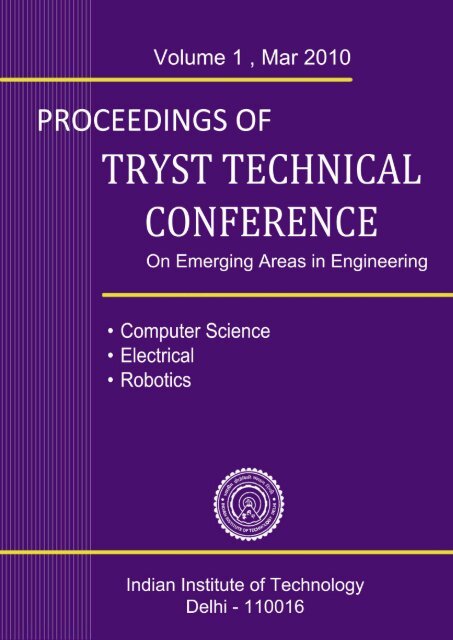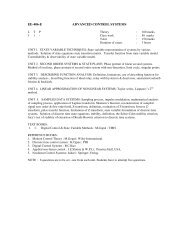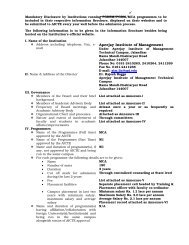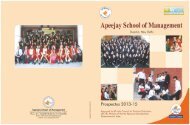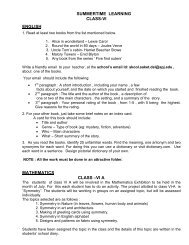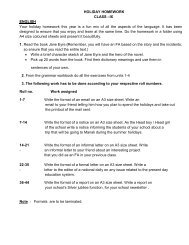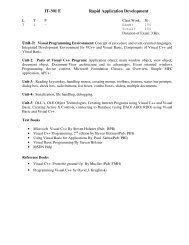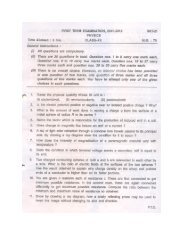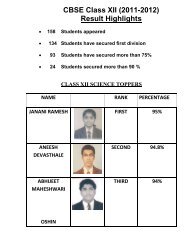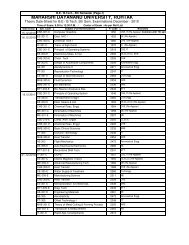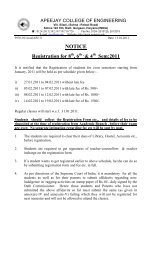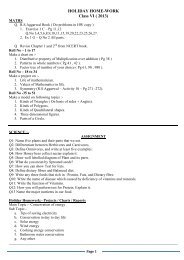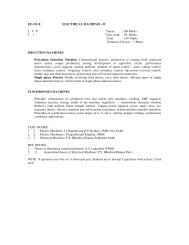acknowledgement - Apeejay College of Engineering, Sohna
acknowledgement - Apeejay College of Engineering, Sohna
acknowledgement - Apeejay College of Engineering, Sohna
Create successful ePaper yourself
Turn your PDF publications into a flip-book with our unique Google optimized e-Paper software.
ACKNOWLEDGEMENT<br />
The Tryst 2010 Team expresses a special <strong>acknowledgement</strong> to the following people for doing a<br />
dedicated job <strong>of</strong> reviewing and selecting the papers:<br />
Ritu Garg (Computer Science),Smruti Padhy (Computer Science), Ehtesham Hassan (Computer<br />
Science), Hitesh Shrimali(Electrical), Priyesh Chauhan(Electrical), M Sultan Siddiqui(Electrical),<br />
Anoop C Nair(Electrical), Gaurang Vakil (Electrical), Vimal Singh (Electrical), Shankar (Electrical),<br />
Kiran (Mechanical), Hariharan (Mechanical), Anand Dhruv (Mechanical), Dr. Anima<br />
Nagar(Mathematics), Dhirendra Singh (Mathematics) , Dinbandhu Pradhan (Mathematics),<br />
Sarvesh (Mathematics), Dr. Anurag Rathore(Biochemical), Dharmendra Kumar<br />
Gupta(Chemistry), Rajesh Chhatra (Chemistry), Nem Singh(Chemistry), R.P. Verma (Chemistry),<br />
Bharat Gadakh (Chemistry), Archana Jain (Chemistry), Dr. Joby Joseph(Physics), Gautam Singh<br />
(Physics), Bhupendra Kumar Sharma (Physics), Charu Chandra Korde (Civil), Vivek Kumar<br />
(Instrument Design & Development Centre), Rajendra Singh Malik (Centre Of Polymer),<br />
Immanual (Chemical <strong>Engineering</strong>) , Jabez (Chemical <strong>Engineering</strong>)
INDEX<br />
Computer Science<br />
1. WiMAX‐A wireless technology for “Y”oung generation<br />
Praneeth Kumar P, Rajashekar B, Mohan Rao R, Sony Winner, Sujith Simon Reddy G 1<br />
2. Adaptive Steganography: Design <strong>of</strong> a robust algorithm for cover image ranking and use <strong>of</strong><br />
hashing as an authentication mechanism<br />
Sugandha, U. Satya Naga Vineeli 10<br />
3. ANN based character recognizer for mobile devices to help visually challenged<br />
M.Karthikeyan,K.K.Prasanna kumar 15<br />
4. Unsupervised Detection <strong>of</strong> Unusual Activities<br />
Saurabh Gupta, Ankit Sagwal, Ayesha Choudhary, Subhashis Banerjee , Ankit Narang 21<br />
5. Establishment <strong>of</strong> Portable Bidirectional Communication for Aiding Rescue Operations after<br />
Disaster<br />
Akhilesh R. Jaiswal, Bharat J. Shinde 27<br />
6. Facial Analysis Between Age Groups Using Distance Matrices<br />
Q. M. Rizvi , R. Asthana 34<br />
7. Gait As A Biometric For Human Recognition<br />
Lekha M.K. Kankane, Yogita A.K. Malpani 38<br />
8. Hiding Sensitive Rule Using Distortion Technique<br />
Lekha M.K. Kankane, Yogita A.K. Malpani 45<br />
9. Image Augmented Inertial Navigation System<br />
M. Sharma, K. Paul, S. Gupta, A. Kansal, S. Dhakar, P. Jain 51<br />
10. iMOUSE – A virtual mouse using face recognition<br />
G.Vaidyanathan, K.Mohan Kumar 55<br />
11. Intelligent transportation system using genetic algorithm for shortest driving time calculation<br />
S.Lokesh raj ,V.Aranganathan ,M.A.karthik kumar 62<br />
12. Internet in Space<br />
Vinay D.Khandagale, Nilesh B. Bhagat 66
13. Neural Networks And Fuzzy Logic In Unmanned Aircraft<br />
S. Thirumurgan, V. S. Venkatraman, M. Praveen 73<br />
14. Steganography<br />
K.Mohan Krishna, K.Agastya Kumar, G.Ganesh Kumar 82<br />
15. The Friend Locator<br />
Harsh Kumar, Harsh Sama, Richa Dhanuka 89<br />
Electrical<br />
16. 3D‐ Face Recognition Using Biometrics<br />
Praneeth Kumar P, Rajashekar B, Mohan Rao R, Sony Winner, Sujith Simon Reddy G 92<br />
17. 4G Technology<br />
Abrar Ahmed T.S., Azarudin. M 105<br />
18. Digital to Digital Converter Using Delta Sigma Modulation<br />
Ketan Bansal, Rhishabh Garg, Shouribrata Chatterjee 114<br />
19. A solution to reduce commercial losses in PowerSystem<br />
B. Karthik, Karthik.Bhattu, 117<br />
20. Density based Energy LEACH Protocol for Wireless Sensor Networks<br />
M. Khulbe, P. Srivastava, R.C. Jain 124<br />
21. Electricity generation: Extraction with conservation<br />
Pawan Kumar 128<br />
22. Euclid Greatest Common Divisor<br />
Shikhar Agarwal , Sandeep Kumar Bindal 131<br />
23. A Proactively Secure Threshold Multisignature Scheme<br />
Subanya.B, Abinesh.K.T, Kavitha Mani.R 134<br />
24. On SHA Family <strong>of</strong> Algorithms<br />
Srijan Sanket, Anshul Jain 142<br />
25. Optical Layer Technology In Telecommunication Network<br />
Miss Suryateja Nagula 145
26. Optimization <strong>of</strong> Power Subsystem in a Picosatellite by Battery Module Restructuring<br />
Ganesan Varun Aiyar 151<br />
27. Privacy Threats in E‐passports Using RFID & Biometrics<br />
Sai Prasanth D.V.,Karthick S., Rajarajan R. 157<br />
28. Security Providence for Luggages Using Bluetooth<br />
S.Karthikeyan, S.Kishore, L.Srinivasan 165<br />
29. Usage <strong>of</strong> PICs’ in EMP bomb resistant circuits<br />
A.V.R.Sharath Chandra, M.Sesha Sai 169<br />
30. Utilization <strong>of</strong> phase changing materials for thermal management <strong>of</strong> mobile electronic devices<br />
Sonal Thengane, Nikhil Bhargava 176<br />
31. Wireless Power Transfer using Small Loop Antennas<br />
Karan Goel, Parikshit Vasisht 181<br />
Robotics<br />
32. Anti Hiv Using Nano Robots<br />
Jeevankumar Reddy.Patil, Manikanta.Gummadidala 184<br />
33. Optimizing storage conditions for fruit ripening process<br />
Pallavi Swaroop, Neha Jain 193<br />
34. Remotely Controlled Combatant Robots in Defence Guided by Telepresence and Immersive VR<br />
Systems<br />
V.Guru viswanath ;K.Vikas;A.Vibinth 197<br />
35. Voice Recognized Automated Pen<br />
Gaurav Rajput, Anway Mukherjee 204
Wireless Power Transfer using Small Loop Antennas 181<br />
Wireless Power Transfer using Small Loop Antennas<br />
Karan Goel # , Parikshit Vasisht *<br />
# Department <strong>of</strong> Electronics and Communication <strong>Engineering</strong>, <strong>Apeejay</strong> <strong>College</strong> Of <strong>Engineering</strong>, <strong>Sohna</strong><br />
* Department <strong>of</strong> Electronics and Communication <strong>Engineering</strong>, <strong>Apeejay</strong> <strong>College</strong> Of <strong>Engineering</strong>, <strong>Sohna</strong><br />
#<br />
Email:karan.goel09@gmail.com<br />
# 9911163191<br />
*<br />
Email:parikshitvasisht@yahoo.com<br />
* 9899315555<br />
Abstract— We propose an effective design to transfer electricity<br />
up to a non-negligible distance without any connecting wires<br />
using small loop Antennas. For demonstration we have designed<br />
a theoretical model for a prototype to transmit electric power up<br />
to 100W wirelessly over mid-range distance (5m) and light a 60W<br />
bulb. We also give an overview <strong>of</strong> the techniques used to design<br />
the prototype and compare the simulation and the actual<br />
practical results <strong>of</strong> the electronics hardware used.<br />
Keywords— Witricity, wireless power transfer, Orcad Pspice<br />
analysis<br />
A. Motivation<br />
I. INTRODUCTION<br />
For the past decade or so there has been a tremendous<br />
growth <strong>of</strong> autonomous electronic devices (such as I-pods,<br />
mobile phones, laptops, PDA etc) which rely primarily on<br />
stored chemical energy for their power needs. If a technology<br />
can be developed to transmit power wirelessly, it will get rid<br />
<strong>of</strong> wire mesh and clutter and portable devices could get<br />
charged wirelessly.<br />
inductive coupling in which the coils need not be in resonance<br />
to exchange energy.<br />
C. Our Approach Vs Existing Approach<br />
Serious research has been going on for the past few years to<br />
develop efficient techniques for transferring power wirelessly,<br />
most notably by the team <strong>of</strong> Kralis <strong>of</strong> MIT and their company<br />
called Witricity (which is a portmanteau for wireless<br />
electricity)[1].However there are a few notable differences<br />
between our approach and the one used by the MIT team.<br />
We have designed the antenna as a single turn coil which<br />
reduces the complexity and cost <strong>of</strong> antennas. Also the whole<br />
prototype including the electronics cointaing the RF Amplifier<br />
has been built indigenously using locally available parts to<br />
ensure minimum costs. Our experimental setup can be<br />
represented by the following diagram.<br />
Wireless power transfer can also be used to power nanodevices<br />
like MEMS and bio-tech devices like pacemakers,<br />
which would prevent the repetitive surgeries a patient needs to<br />
undergo for charging his pacemaker.<br />
The project required an extensive practical and theoretical<br />
knowledge <strong>of</strong> both <strong>Engineering</strong> electromagnetic theory and<br />
analog electronics and thus provided us with a challenging<br />
opportunity to understand these core concepts <strong>of</strong> Electrical<br />
engineering at a much deeper level.<br />
B. Theory<br />
The fundamental physics behind wireless energy transfer is<br />
magnetic resonance. This resonance is similar to the<br />
mechanical resonance which can be easily observed in the<br />
shattering <strong>of</strong> glass experiment. When two coils are in<br />
magnetic resonance, they tend to exchange energy between<br />
themselves while interacting negligibly with Extraneous<br />
objects. Note that the technique is different from simple<br />
Fig. 1 The Prototype setup<br />
Tryst Technical Conference, IIT Delhi 13-14 March, 2010
Wireless Power Transfer using Small Loop Antennas 182<br />
II. POWER SUPPLY DESIGN<br />
The Power Supply is used to generate a High Frequency<br />
sinusoidal current which generates a HF alternating magnetic<br />
field when connected to the resonant coil (Transmitter). The<br />
schematic Diagram below shows Oscillator and the Voltage<br />
Amplifier stage <strong>of</strong> the power supply<br />
Fig. 5 Actual Digital Oscilloscope Output<br />
Fig. 2 10MHz Colpitts Oscillator and Voltage Amplifier Schematic<br />
The general purpose amplifier transistor Q2N3904 is used<br />
for designing the Oscillator and High voltage transistor<br />
MPSA44 is used in the first stage <strong>of</strong> the transistor. The first<br />
stage <strong>of</strong> voltage amplifier is designed with an input impedance<br />
<strong>of</strong> 50Ω and a voltage gain <strong>of</strong> about 55dB.<br />
A. Oscillator Design<br />
We decided to use the Colpitts Oscillator to generate the 10<br />
MHz sinusoidal wave due to its low part count and inherent<br />
simplicity and stability. The circuit has been designed using<br />
Cadence Orcad Package and simulated using Pspice. The<br />
Oscillator circuit is shown in figure 2. The simulated output <strong>of</strong><br />
oscillator has a peak voltage <strong>of</strong> ≈ 500mV [figure 4].<br />
Thus we have acceptable performance and acceptable match<br />
between theoretical and practical results for the oscillator.<br />
Note that the noise on the waveform presents no disadvantage<br />
as we simply want to create a high frequency alternating<br />
magnetic field to transfer power and are not doing a<br />
communication protocol. (E.g. Modulation).<br />
B. Voltage Amplifier Design<br />
The ac π-model was used to analyse and design the voltage<br />
amplifier [figure 6].<br />
Fig. 6 Equivalent π-model <strong>of</strong> voltage Amplifier<br />
The MPSA44 High Voltage transistor is biased with a<br />
collector current <strong>of</strong> IC=100mA. The circuit schematic is<br />
shown in figure 2.<br />
The Output Power <strong>of</strong> the voltage amplifier is 1W which is<br />
given to a Class AB Push Pull Power Amplifier with a Power<br />
gain <strong>of</strong> about 100.This gives an output power <strong>of</strong> 100W which<br />
is connected to the resonant coils.<br />
Fig. 4 Simulated Oscillator output in Pspice<br />
The Actual Digital Oscilloscope output <strong>of</strong> the breadboard<br />
prototype is ≈328mV [figure 5].<br />
Tryst Technical Conference, IIT Delhi 13-14 March, 2010
Wireless Power Transfer using Small Loop Antennas 183<br />
III. ANTENNA DESIGN<br />
Two single loop antennas [figure 6] have been designed<br />
which have an impedance <strong>of</strong> about 8Ω. These antennas are<br />
connected to two bank capacitors whose capacitance can be<br />
varied to tune the resonant frequencies for both single loop<br />
Antennas. The tuning <strong>of</strong> the two antennas is critical; otherwise<br />
power will not be transferred at maximum efficiency.<br />
Fig. 6 Actual Photo <strong>of</strong> the Single Loop Antenna<br />
The maximum spacing between the resonant coils (transmitter<br />
and receiver) is calculated using the following derived<br />
equation.<br />
This equation is derived by equating the near field and the far<br />
field due to the loop antennas. R is the distance between the<br />
two coils (Transmitter and Receiver) and λ is the wavelength<br />
<strong>of</strong> the field. For a frequency <strong>of</strong> 10 MHz, the maximum<br />
theoretical separation possible between the two resonant coils<br />
is 5m.<br />
IV. CONCLUSIONS<br />
In conclusion, we investigate the feasibility <strong>of</strong> wireless<br />
power transfer and present a theoretical model for a prototype<br />
which is built from ground up by implementing the basic<br />
concepts <strong>of</strong> Electronics and Electromagnetics. Note that the<br />
technology is completely safe for Human beings as living<br />
beings are negligibly affected by the resonant magnetic field<br />
generated in our experiment which is <strong>of</strong> the same order as that<br />
<strong>of</strong> the Earth’s magnetic field.<br />
We also conclude that the current technique can be refined<br />
and further research can be done to boost efficiency and/or<br />
range and pave the way for commercial exploitation <strong>of</strong> the<br />
technology.<br />
REFERENCES<br />
The current supplied by the power supply is given by<br />
where I is the alternating current. This current generates a<br />
magnetic field, which is coupled between the two resonant<br />
coils and alternating current is generated in the receiver coil.<br />
Thus power is thus transferred to the receiving antenna which<br />
is connected to a resistive load.<br />
[1] A. Kurs, A. Karalis, R. M<strong>of</strong>fatt, J.D. Joannopoulos, P. Fisher, M. Soljačić,<br />
“Wireless Power Transfer via Strongly Coupled Magnetic Resonances,”<br />
Science, Vol. 317, 6 July 2007.<br />
[2] A.Malvino and David J Bates, Electronic Principles 7 th Edition, Tata<br />
McGraw Hill Special Indian Edition 2007.<br />
[3] W.H Hyat and J.A Buck, <strong>Engineering</strong> Electromagnetics 7 th Edition, Tata<br />
McGraw-Hill Special Indian Edition 2007.<br />
.<br />
Tryst Technical Conference, IIT Delhi 13-14 March, 2010


